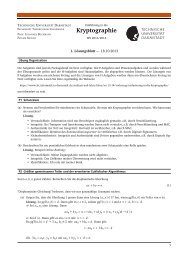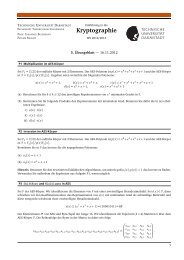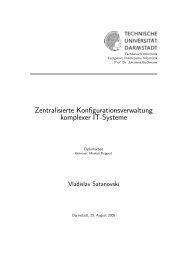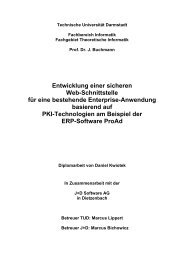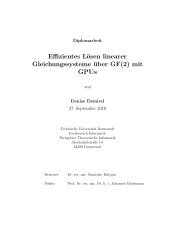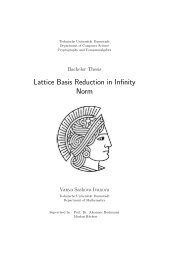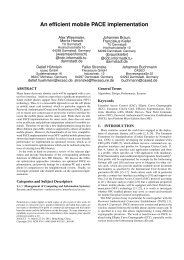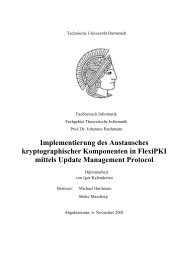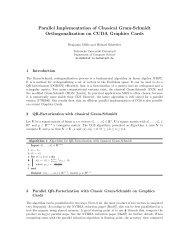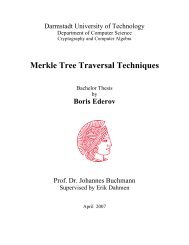Design and Implementation of a Cryptographic Plugin for E-mail ...
Design and Implementation of a Cryptographic Plugin for E-mail ...
Design and Implementation of a Cryptographic Plugin for E-mail ...
You also want an ePaper? Increase the reach of your titles
YUMPU automatically turns print PDFs into web optimized ePapers that Google loves.
<strong>Design</strong> <strong>and</strong> <strong>Implementation</strong> <strong>of</strong> a <strong>Cryptographic</strong><br />
<strong>Plugin</strong> <strong>for</strong> E-<strong>mail</strong> Clients<br />
Steven Arzt<br />
Technische Universität Darmstadt,<br />
Department <strong>of</strong> Computer Science,<br />
Hochschulstraße 10, D-64289 Darmstadt, Germany<br />
s arzt@rbg.in<strong>for</strong>matik.tu-darmstadt.de<br />
Abstract. Most applications that use cryptography implement <strong>and</strong> use<br />
only a limited set <strong>of</strong> cryptographic algorithms. In addition it is not easy<br />
to update these applications <strong>and</strong> extend their provided set <strong>of</strong> algorithms.<br />
In this paper we concentrate on e-<strong>mail</strong> clients <strong>and</strong> discuss a cryptographic<br />
plugin with focus on Mozilla Thunderbird. We provide a modular framework<br />
<strong>for</strong> exchangeable signature, hash, <strong>and</strong> encryption algorithms. We<br />
create an integration layer between e-<strong>mail</strong> applications <strong>and</strong> cipher implementations.<br />
With such a layer, both parts can be exchanged freely <strong>and</strong><br />
independently <strong>of</strong> each other which is not possible with current solutions<br />
because they mostly rely upon a static set <strong>of</strong> ciphers <strong>and</strong> hash functions<br />
or directly integrate the ciphers into the application code.<br />
Keywords: Certificates, S/MIME, cryptography, smart cards, e-<strong>mail</strong><br />
clients.<br />
1 Introduction<br />
Signing e-<strong>mail</strong>s is a common task today. S/MIME specified in [Ram04b] <strong>and</strong><br />
[Ram04a] is mostly used <strong>and</strong> integrated in common <strong>mail</strong> clients like Mozilla<br />
Thunderbird or Micros<strong>of</strong>t Outlook. However, almost all application only provide<br />
a st<strong>and</strong>ard set <strong>of</strong> algorithms, <strong>for</strong> example RSA [RSA78], DSA [NT94], <strong>and</strong><br />
ECDSA [ANS05]. There is no possibility to use different cryptographic functions<br />
like Niederreiter (CFS) [CFS01].<br />
Due to the limited lifetime <strong>of</strong> cryptographic algorithms <strong>and</strong> hash functions<br />
in general as well as the prospect <strong>of</strong> quantum algorithms breaking most numbertheoretic<br />
ciphers <strong>and</strong> signature schemes in particular, we need alternative methods<br />
<strong>of</strong> cryptography. Especially RSA which is one <strong>of</strong> the most popular ciphers<br />
used in e-<strong>mail</strong> signature is no longer secure with quantum computers. There<strong>for</strong>e<br />
an easy to implement mechanism to use strong <strong>and</strong> innovative cryptography<br />
while preserving practical usability has to be developed.<br />
Another motivation is to easily update cryptosystems. If one cipher or hash<br />
function has reached the end <strong>of</strong> its lifetime, it has to be replaced either by a<br />
stronger variant or a completely new cryptographic primitive. New cipher developments<br />
may also be more efficient while providing the same level <strong>of</strong> security as
existing ones. In either case, the update has to be done as smoothly as possible.<br />
Important systems should not be unavailable due to this maintenance which<br />
is however necessary necessary with many current systems. This happens because<br />
cryptographic primitives are <strong>of</strong>ten hard-coded into application programs<br />
or operating systems.<br />
The JCA/JCE framework ([JCA]) can be used <strong>for</strong> providing base operations<br />
like signing, encrypting, <strong>and</strong> hashing as custom providers. Many existing ciphers<br />
are available as JCA providers. However, this still requires a lot <strong>of</strong> ef<strong>for</strong>t when<br />
integrating novel ciphers into e-<strong>mail</strong> systems due to the missing integration into<br />
their respective APIs or extensions frameworks.<br />
For the use <strong>of</strong> smart cards, a communication library is necessary. The input<br />
data available on the computer has to be transferred to the card reader,<br />
the respective signature function on the smartcard has to be invoked, <strong>and</strong> the<br />
result needs to be transferred back to the application on the computer. While<br />
PKCS#11 provides a common st<strong>and</strong>ard <strong>for</strong> basic operations <strong>of</strong> this kind, many<br />
functions <strong>of</strong> modern cards are missing. Implementors thus provide card <strong>and</strong> plat<strong>for</strong>m<br />
specific non-st<strong>and</strong>ardized solutions <strong>for</strong> single applications. Whenever new<br />
card types or applications are developed, these libraries need to be separately<br />
adapted, tested, <strong>and</strong> distributed <strong>for</strong> all combinations <strong>of</strong> user applications <strong>and</strong><br />
card models.<br />
There<strong>for</strong>e we design <strong>and</strong> implement an extensible plat<strong>for</strong>m <strong>for</strong> coupling applications<br />
<strong>and</strong> exchangeable cryptographic modules <strong>for</strong> the different ciphers. As<br />
an example <strong>for</strong> the application interface, we integrate our solution into a widely<br />
used e-<strong>mail</strong> client. With our plat<strong>for</strong>m, all new developments <strong>of</strong> cryptographic<br />
algorithms or system changes can either be provided as new modules or incorporated<br />
into dedicated existing ones. This does not require changes to existing<br />
modules. With the support provided by the plat<strong>for</strong>m, the necessary development<br />
<strong>and</strong> maintenance ef<strong>for</strong>t is minimized.<br />
This paper is organized as follows. We address the problem we are working<br />
on in Section 2 <strong>and</strong> then give a general overview <strong>of</strong> our solution in Section 3.<br />
In Section 4 we show how the solution is designed in detail <strong>for</strong> signing <strong>mail</strong>s<br />
<strong>and</strong> managing certificates <strong>and</strong> private keys. In Section 5 we describe how our<br />
s<strong>of</strong>tware is integrated into the Mozilla Thunderbird e-<strong>mail</strong> client. Section 6 lists<br />
<strong>and</strong> describes the third-party components we currently use. In Section 7 we give<br />
an overview over all implemented signature <strong>and</strong> key management modules. We<br />
conclude our paper in Section 8.<br />
2 The Problem<br />
A modular framework providing exchangeable ciphers <strong>for</strong> data signature is required<br />
that overcomes the restriction to the fixed <strong>and</strong> limited set <strong>of</strong> signature<br />
algorithms <strong>and</strong> hash functions implemented into many applications. In this paper,<br />
we focus on electronic <strong>mail</strong> which is one <strong>of</strong> the most widespread <strong>and</strong> most<br />
frequently used applications. Our concrete implementation is integrated into<br />
Mozilla Thunderbird which is a famous <strong>and</strong> commonly used <strong>mail</strong> client. Still,
our solution is designed to be extended <strong>for</strong> other <strong>mail</strong> clients like Micros<strong>of</strong>t Outlook,<br />
too. All clients providing sufficiently sophisticated extension APIs can be<br />
integrated.<br />
Integrating new cryptographic primitives into existing products requires wide<br />
system changes as the built-in cipher set has <strong>of</strong>ten been regarded more or less<br />
static during development. The extension features a growing number <strong>of</strong> s<strong>of</strong>tware<br />
systems provides help with the task, but they are <strong>of</strong>ten too complex <strong>for</strong> practically<br />
testing newly developed signature functions with. This results in a high<br />
amount <strong>of</strong> source code necessary. Additionally, extension or plugin APIs <strong>of</strong>ten<br />
are not specially designed <strong>for</strong> cryptography, so the developer has to manually<br />
integrate his plugin into the host’s control flow. For Mozilla Thunderbird, <strong>for</strong><br />
example, this means that every such plugin has build its own infrastructure <strong>for</strong><br />
obtaining the source <strong>mail</strong> message, integrating the signature, <strong>and</strong> then inject<br />
the result back to the original chain <strong>of</strong> processing without breaking it even if<br />
arbitrary other plugins are used, too. Besides that, an own S/MIME implementation<br />
needs to be provided or an existing one to be manually integrated with<br />
the plugin in addition to the control flow integration problem stated above.<br />
Implementing new cryptographic algorithms as JCA/JCE providers is a common<br />
method <strong>of</strong> delivering new developments to a wider community <strong>of</strong> users as<br />
almost all Java applications are based on this architecture <strong>and</strong> can thus use it.<br />
Many <strong>mail</strong> clients, however, are not written in Java, so the additional integration<br />
layer described above is again required.<br />
We introduce such a layer with our solution called Thundercrypt. With Thundercrypt,<br />
algorithm implementations only need to focus on direct signing <strong>of</strong> binary<br />
data. Our s<strong>of</strong>tware per<strong>for</strong>ms all communication <strong>and</strong> control flow h<strong>and</strong>ling<br />
with the <strong>mail</strong> client.<br />
In corporate or institute networks, s<strong>of</strong>tware deployment is a concern which<br />
makes it more difficult to quickly exchange ciphers no longer meeting the required<br />
security levels. Thundercrypt can work as a network service providing a single<br />
point <strong>of</strong> maintenance <strong>and</strong> key management which additionally minimizes the<br />
risk <strong>of</strong> key compromise.<br />
Many existing frameworks <strong>for</strong> <strong>mail</strong> signature rely on specific means <strong>of</strong> key<br />
storage. Micros<strong>of</strong>t Outlook uses the Windows key store, Mozilla Thunderbird<br />
uses its own key store, other systems store keys in the Java keystore. Thundercrypt<br />
flexibly combines the cryptographic modules with a configurable set <strong>of</strong> key<br />
store modules reducing the dependance upon one specific system <strong>and</strong> facilitating<br />
the migration between different signature implementations.<br />
3 <strong>Design</strong><br />
In this chapter, we first discuss the general design <strong>of</strong> the Thundercrypt system.<br />
Then we show how the configuration infrastructure as the linking part between<br />
infrastructure components <strong>and</strong> freely exchangeable modules works.
3.1 General<br />
Thundercrypt consists <strong>of</strong> four main parts: The communication services h<strong>and</strong>le<br />
the communication between the Thundercrypt application <strong>and</strong> the <strong>mail</strong> client,<br />
either via a direct integration <strong>of</strong> the communicator classes into Thunderbird 3<br />
or newer or via a socket-based server solution. The server can be configured<br />
<strong>for</strong> remote or only local access. The second part contains the key management<br />
modules. A key management module provides other Thundercrypt modules with<br />
X.509 certificates <strong>and</strong> (if applicable) corresponding private keys through a common<br />
interface. There is one module <strong>for</strong> every key store type. The third part<br />
contains the cryptographic modules which per<strong>for</strong>m the signing <strong>and</strong> decryption<br />
operations. There is one module <strong>for</strong> every algorithm or external cryptographic<br />
library to be used. The segregation <strong>of</strong> key management <strong>and</strong> cryptographic operations<br />
enables an easy combination <strong>of</strong> different key stores with different cryptographic<br />
providers. For instance, an RSA key pair can be obtained either from a<br />
file or the Java Key Store <strong>and</strong> can both be used with native JRE providers <strong>and</strong><br />
the FlexiProvider [Gro] RSA implementation. The fourth part are infrastructure<br />
services available to all other modules. They implement common features<br />
like logging <strong>and</strong> configuration management. This is especially useful when integrating<br />
new ciphers or key management modules as they can be built upon an<br />
existing, flexible, <strong>and</strong> consistent infrastructure simplifying module development<br />
<strong>and</strong> management. All modules <strong>and</strong> parts are loosely coupled so that they can be<br />
exchanged without much ef<strong>for</strong>t. Key management <strong>and</strong> cryptographic modules<br />
are instantiated by factory classes loading the modules specified in the configuration<br />
file. As this method is applied <strong>for</strong> both built-in <strong>and</strong> additional modules,<br />
adding a new modules can be done by just providing a compatible class <strong>and</strong> registering<br />
its fully qualified class name in the configuration file. Likewise, only the<br />
class name in the configuration file needs to be changed <strong>for</strong> switching modules.<br />
The loose coupling also holds true <strong>for</strong> the communication services part, so a web<br />
service interface or interfaces to other <strong>mail</strong> clients like Micros<strong>of</strong>t Outlook can<br />
be implemented in the future. After developing a new communication module,<br />
Thundercrypt’s full functionality is instantly available to the new client.<br />
3.2 The modular configuration by example<br />
As described in the general part, Thundercrypt uses a uni<strong>for</strong>m configuration file<br />
centrally processed by infrastructure components that make the respective parts<br />
available to the different modules. The configuration example in figure 2 uses<br />
the TUD smartcard [BF] <strong>for</strong> signing <strong>mail</strong>s, but loads the user certificate that is<br />
embedded into the <strong>mail</strong> from a file on a local hard disk <strong>for</strong> enhanced per<strong>for</strong>mance.<br />
In this example configuration, the PIN <strong>for</strong> decrypting the private key is specified<br />
in the configuration file <strong>for</strong> simplified testing. If the respective element is<br />
omitted, the user is asked <strong>for</strong> his PIN or password every time he sends a signed<br />
e-<strong>mail</strong>.<br />
The certificate can also be loaded from the card that is used <strong>for</strong> signing by just
Thunderkrypt Client<br />
Components<br />
Communication<br />
Services<br />
Module 1<br />
Module 2<br />
Key Management<br />
Services<br />
Thunderkrypt Server Components<br />
Thunderkrypt Server<br />
Module 3 Module 1<br />
Fig. 1. General s<strong>of</strong>tware design<br />
Module 2<br />
Infrastructure Services<br />
<strong>Cryptographic</strong> Module<br />
Services<br />
Module 3<br />
exchanging the configured certificate manager. With such a configuration, only<br />
the physical card needs to be exchanged in the case <strong>of</strong> a key compromise <strong>for</strong><br />
example <strong>and</strong> the system continues to function without any further changes. On<br />
the other h<strong>and</strong>, reading the certificate from the card is significantly slower than<br />
using a file on a hard disk or RAM disk. As a compromise, Thundercrypt also<br />
implements a cache <strong>for</strong> private keys <strong>and</strong> certificates. With smart cards, the private<br />
key cache is deactivated.<br />
The infrastructure components parse the elements <strong>and</strong> associate<br />
them with the correct classes as defined by the “target” attribute. If a class<br />
needs access to its configuration data, it can directly access the respective DOM<br />
node.<br />
4 Modules by Example<br />
For a better overview over the interface <strong>for</strong> building cryptographic provider<br />
<strong>and</strong> certificate management modules, this chapter explains one cryptographic<br />
provider <strong>and</strong> one certificate manager as examples.
Fig. 2. Configuration example<br />
4.1 The Java native cryptographic provider<br />
As an example <strong>for</strong> a cryptographic module, we take the Java native cryptographic<br />
provider. The Java native provider uses the basic JCA functions <strong>for</strong><br />
creating RSA signatures <strong>and</strong> is thus relatively simple.<br />
Modules are implemented as classes extending the AbstractMailProvider class.<br />
Signature <strong>and</strong> management operations are implemented as abstract method overwrites<br />
which enables the Thundercrypt infrastructure to directly integrate the<br />
new module.<br />
As this basic class directly works on JavaMail’s MimeMesssage objects, implementors<br />
have to provide their own S/MIME implementation. While this option<br />
<strong>of</strong>fers great flexibility when required, it leads to unnecessary complexity in most<br />
cases. There<strong>for</strong>e, Thundercrypt provides the AbstractMailProviderSPI class implementing<br />
the S/MIME features <strong>and</strong> redirecting all signature requests to new<br />
abstract methods working on byte arrays instead <strong>of</strong> <strong>mail</strong> messages. Modules thus<br />
only need to be capable <strong>of</strong> signing arbitrary byte data <strong>for</strong> the use with Thundercrypt.<br />
The UML diagram in Figure 3 shows the abstract methods defined<br />
by the AbstractMailProvider abstract base class <strong>and</strong> implemented by the Java<br />
native provider in class JavaMailSignatureProvider. As most <strong>of</strong> these methods<br />
just return provider-specific, but fixed management in<strong>for</strong>mation (like algorithm<br />
names), a simple provider like this one is implemented with minimal development<br />
ef<strong>for</strong>t. Certificate <strong>and</strong> private key h<strong>and</strong>ling is completely used as provided<br />
by the certificate manager infrastructure. As the modules are intended to be interface<br />
modules <strong>for</strong> independently developed cipher implementations, most steps<br />
in the signature creation process can just be delegated to this implementation.<br />
The provider’s main responsibility is converting input <strong>and</strong> output data between<br />
Thundercrypt’s module interface <strong>and</strong> the arbitrary interface <strong>of</strong> the cipher implementation.
4.2 The file based certificate manager<br />
The file based certificate manager provides certificates <strong>and</strong> private keys loaded<br />
from DER-encoded certificates <strong>and</strong> PKCS#12 files.<br />
The UML diagram in Figure 4 shows the abstract methods defined by the AbstractCertificateManager<br />
abstract base class <strong>and</strong> implemented by the FileBased-<br />
CertManager concrete manager class. As with the signature provider, there are<br />
some functions that return static in<strong>for</strong>mation data about the manager class.<br />
The function getMailSigningCertificate loads the default certificate to be used<br />
<strong>for</strong> signing e-<strong>mail</strong>s. The function getPrivateKeyForCertificate returns the private<br />
key associated with a given certificate if available. With getPinForCertificate,<br />
one can get the password or PIN <strong>for</strong> private key decipherment if one has been<br />
configured or is otherwise available in the certificate manager. With isPinRequiredForPrivateKey,<br />
you can check whether you need a PIN or password to<br />
decipher the private key or whether it is freely usable (unprotected).<br />
5 Integration into Thunderbird<br />
Integrating external signature processes into Thunderbird’s <strong>mail</strong> sending process<br />
is complex. If a user signs a message, other application features like saving <strong>mail</strong>s<br />
as drafts or using a spellchecker that warns if a <strong>mail</strong> with spelling mistakes is<br />
to be sent must still be working. This means that the plugin cannot make any<br />
assumptions about additional steps in the <strong>mail</strong> sending process. Thus, just extracting<br />
the <strong>mail</strong> <strong>for</strong> external processing an then sending a changed (e.g. signed)<br />
version is not feasible. In addition, the plugin should work as com<strong>for</strong>tably <strong>and</strong><br />
end-user friendly as Thunderbird’s native S/MIME functions, especially without<br />
requiring the user to manually transfer signature files to or from an external application.<br />
In order create a client component accomplishing these challenges, we<br />
had to implement a full integration into the <strong>mail</strong> client’s <strong>mail</strong> sending process.<br />
The <strong>mail</strong> processing starts when the user clicks on Thunderbird’s normal<br />
“Send message” button in the compose window. This call is redirected into<br />
Thundercrypt’s own code. If the user has not chosen to sign the message, the<br />
call is <strong>for</strong>warded to the base Thunderbird code as is. If a signature is to be made,<br />
the message is extracted <strong>and</strong> passed on to the server code <strong>for</strong> calculating the<br />
signature which is integrated into the <strong>mail</strong> as an attachment. Next, the <strong>mail</strong><br />
headers are changed to mark the message as signed <strong>and</strong> point MIME multipart<br />
element containing the attached signature. Finally, the message is sent via Thunderbird’s<br />
normal features <strong>for</strong> not breaking other plugins or organizer functions<br />
(like the “Sent messages” folder). The general process <strong>of</strong> sending a signed <strong>mail</strong><br />
message is shown in Figure 5.<br />
We will now address the steps in detail. The “Extract Message” step is necessary<br />
because Thunderbird generates the <strong>mail</strong> message directly be<strong>for</strong>e sending<br />
or saving it. Thus, the message stream is not directly accessible from the compose<br />
window in which the plugin’s send h<strong>and</strong>ler is loaded. As a workaround,<br />
Thundercrypt saves the message as a draft <strong>and</strong> then loads the stored message
either from the local <strong>mail</strong> box folder’s storage file when using SMTP with local<br />
folders or as a stream when using remote IMAP folders. The temporary draft is<br />
retained <strong>for</strong> further steps.<br />
The message stream is then transferred to the Thundercrypt server which per<strong>for</strong>ms<br />
the signature <strong>and</strong> sends an encoded signature back to the Javascript client.<br />
As Thunderbird cannot attach files to already stored drafts without opening the<br />
composer which would have meant a more complex h<strong>and</strong>ling <strong>for</strong> the developer<br />
<strong>and</strong> an irritating window that opens up <strong>for</strong> a second <strong>and</strong> then automatically<br />
closes again <strong>for</strong> the user, we had to change the message outside Thunderbird.<br />
In order to accomplish this task, the first step was extended to attach a dummy<br />
file be<strong>for</strong>e saving the draft. This dummy attachment can then be replaced by<br />
the actual signature in the serialized <strong>mail</strong> data.<br />
Up to the current step, the message is a normal unsigned e-<strong>mail</strong> with an arbitrary<br />
attachment. The next step changes the <strong>mail</strong> headers marking the message<br />
as signed with the attachment as the signature data.<br />
External message processing is now complete. If local message folders are used,<br />
the respective data file is read from the pr<strong>of</strong>ile folder <strong>and</strong> the original temporary<br />
draft is replaced be<strong>for</strong>e reloading the folder data in Thunderbird. For IMAP<br />
folders, the new message is streamed to the IMAP server.<br />
For sending the changed <strong>mail</strong>, Thunderbird’s function <strong>for</strong> sending messages later<br />
(a part <strong>of</strong> its <strong>of</strong>fline working features) is used. The message is copied into the<br />
“Unsent messages” folder that is afterwards scheduled <strong>for</strong> sending. From now<br />
on, the message is a normal (but delayed) message again.<br />
The whole process described takes a few seconds to complete. Given the internal<br />
complexity created by the external processing steps, the per<strong>for</strong>mance is still<br />
better than expected.<br />
5.1 Alternative Integration Methods<br />
We chose the approach <strong>of</strong> implementing a st<strong>and</strong>alone plugin <strong>and</strong> redirecting<br />
some <strong>of</strong> Thunderbird’s internal chrome functions to own code. The own code<br />
then per<strong>for</strong>ms the necessary preprocessing (generating the signature) <strong>and</strong> then<br />
sends the manipulated message with Thunderbird’s original functions. This provided<br />
the greatest flexibility <strong>and</strong> guaranteed our independence <strong>of</strong> other external<br />
projects. We also considered <strong>and</strong> decided against the following alternatives:<br />
– Use an existing Thunderbird plugin like Enig<strong>mail</strong> [Pro] as a basis upon which<br />
to build the own solution. This approach was however infeasible as we would<br />
have had to manage a large code basis split from a project under constant<br />
development with whose development we would have had to keep up as to<br />
constantly integrate their changes into our split or vice versa.<br />
– Integrate a custom S/MIME implementation into Thunderbird. This approach<br />
has shown to be infeasible since the <strong>mail</strong> signature features <strong>of</strong> Thunderbird<br />
are only available as a monolithic black box that does not allow<br />
enough interference <strong>for</strong> custom ciphers without changing the Thunderbird
source code. Since Thunderbird is open source, this would have been possible,<br />
but would have created the same problems that made us decide against<br />
extending an existing plugin.<br />
6 Used Components<br />
For h<strong>and</strong>ling S/MIME messages, we use an implementation taken from the free<br />
BouncyCastle library (www.bouncycastle.de) . The BouncyCastle provider is<br />
used “as is” while there have been minor changes to the S/MIME classes. For<br />
writing out signatures, we employ internal classes that are normally not part <strong>of</strong><br />
the external interface, <strong>for</strong> instance. As this still does not provide us with the<br />
required flexibility, we plan to provide our own S/MIME implementation in the<br />
future, especially with regard to integrating post-quantum ciphers at some later<br />
point.<br />
The built-in FlexiProvider cryptographic module uses FlexiProvider (www.<br />
flexiprovider.de) [Gro].<br />
For h<strong>and</strong>ling <strong>mail</strong> messages, we use the Java <strong>mail</strong> API “javax.<strong>mail</strong>”. Base64<br />
encoding <strong>and</strong> decoding is done with the CoDec package (www.source<strong>for</strong>ge.net/<br />
projects/codec/)).<br />
The TUD card cryptographic provider uses the PC/SC API <strong>of</strong> Java 6.0.<br />
7 Implemented Modules<br />
This section addresses the key management <strong>and</strong> cryptographic modules already<br />
implemented in Thundercrypt. At the moment, there are modules <strong>for</strong> reading<br />
X.509 certificates from DER encoded files, the Java Key Store, the TUD Card<br />
(student/employee smart card at Technische Universität Darmstadt) <strong>and</strong> the native<br />
operating system store on Windows systems. Private keys can be read from<br />
PKCS#12 files, the Java Key store, <strong>and</strong> the Windows native store. For signing<br />
e-<strong>mail</strong>s with the RSA cipher, the BouncyCastle provider, the FlexiProvider 1<br />
implementation, the st<strong>and</strong>ard Java implementation, the native Windows crypto<br />
API functions, <strong>and</strong> the TUD card can be used. When using the native Windows<br />
module, signing is also possible with non-exportable keys from the native store.<br />
For decrypting e-<strong>mail</strong>s, there is currently only a legacy module that has been<br />
migrated to Thundercrypt as a pro<strong>of</strong>-<strong>of</strong>-concept.<br />
8 Conclusions<br />
We have created a flexible, easily extendable <strong>and</strong> yet versatile plat<strong>for</strong>m providing<br />
new cryptographic e-<strong>mail</strong> functions to the Mozilla Thunderbird e-<strong>mail</strong> client.<br />
With our plat<strong>for</strong>m, new ciphers <strong>and</strong> key management modules can be integrated<br />
1 FlexiProvider’s DSA functions are also available via the respective Thundercrypt<br />
module.
as modules without any changes to the plat<strong>for</strong>m itself, closing the gap between<br />
cryptographic research <strong>and</strong> practical application.<br />
For the future, we plan to provide our own S/MIME implementation <strong>and</strong><br />
integrate the process <strong>of</strong> signature verification into Thundercrypt which by now<br />
remains with the <strong>mail</strong> client. For verifying signatures inside Thundercrypt, we<br />
need a more flexible S/MIME h<strong>and</strong>ler that allows access to the parsed data<br />
without making any assumptions about the used algorithms. Another point <strong>of</strong><br />
extension are the <strong>mail</strong> encryption <strong>and</strong> decryption modules that by now only<br />
exist as one pro<strong>of</strong>-<strong>of</strong>-concept implementation. Like with the signature modules,<br />
we plan to provide multiple encryption methods. The high level <strong>of</strong> architectural<br />
flexibility also allows us to implement the plugin <strong>for</strong> other e-<strong>mail</strong> clients allowing<br />
extensions.<br />
The author thanks Eduardo Lidanski, Zakaria Drissi Maniani <strong>and</strong> Dirk Voll<strong>and</strong><br />
<strong>for</strong> starting the project <strong>and</strong> designing a first prototype <strong>of</strong> the application.<br />
References<br />
[ANS05] American National St<strong>and</strong>ards Institute ANSI. X9.62: Public Key Cryptography<br />
<strong>for</strong> the Financial Services Industry: The Elliptic Curve Digital Signature<br />
Algorithm (ECDSA), November 2005.<br />
[BF] J. Becker <strong>and</strong> M. Frohna. Tudcard. http://www.hrz.tu-darmstadt.de/<br />
dienste/id/tudcard.<br />
[CFS01] N. Courtois, M. Finiasz, <strong>and</strong> N. Sendrier. How to achieve a maceliece-based<br />
digital signature scheme. Asiacrypt 2001, 248, 2001.<br />
[Gro] Theoretical Computer Science Research Group. Flexiprovider s<strong>of</strong>tware <strong>and</strong><br />
api documentation. http://www.flexiprovider.de.<br />
[JCA] Java cryptography architecture (jca) reference guide. http://java.sun.com/<br />
javase/6/docs/technotes/guides/security/crypto/CryptoSpec.html.<br />
[NT94] National Institute <strong>of</strong> St<strong>and</strong>ards NIST <strong>and</strong> Technology. FIPS 186 – Digital<br />
Signature St<strong>and</strong>ard (DSS), May 1994. http://www.itl.nist.gov/<br />
fipspubs/fip186.htm.<br />
[Pro] The Engi<strong>mail</strong> Project. Openpgp e<strong>mail</strong> security <strong>for</strong> mozilla applications.<br />
http://enig<strong>mail</strong>.mozdev.org.<br />
[Ram04a] B. Ramsdell. Secure / Multipurpose Internet Mail Extensions (S/MIME)<br />
Version 3.1 Certificate H<strong>and</strong>ling. IETF Request For Comments, 3850, July<br />
2004.<br />
[Ram04b] B. Ramsdell. Secure / Multipurpose Internet Mail Extensions (S/MIME)<br />
Version 3.1 Message Specification. IETF Request For Comments, 3851, July<br />
2004.<br />
[RSA78] R. Rivest, A. Shamir, <strong>and</strong> L. Adleman. A Method <strong>for</strong> Obtaining Digital<br />
Signatures <strong>and</strong> Public-Key Cryptosystems. Communications <strong>of</strong> the ACM,<br />
21(2):120–126, February 1978.
AbstractMailProvider<br />
+getProviderName() : string<br />
+supportsProviderType(in ProviderType : MailProviderType) : bool<br />
+setCertificateManager(in CertManager : AbstractCertificateManager)<br />
+signMailMessage(in MailMessage : MimeMessage, in PrivateKeyPin : string) : string<br />
+signMailMessage(in MailMessage : MimeMessage, in NormalizeLineBreaks : bool, in PrivateKeyPin : string) : string<br />
+signData(in DataToSign : byte[], in PrivateKeyPin : string) : byte[]<br />
+decryptMailMessage(in MailMessage : MimeMessage, in PrivateKeyPin : string) : string<br />
+isPinRequired() : bool<br />
+normalizeMessage(in Message : MimeMultipart)<br />
+getNormalizeLineBreaks() : bool<br />
AbstractMailProviderSPI<br />
#UnsafePreInit()<br />
+signMailMessage(in MailMessage : MimeMessage, in PrivateKeyPin : string) : string<br />
+supportsProviderType() : MailProviderType<br />
#getSigningCertificate() : X509Certificate<br />
#getSigningAlgorithmName() : string<br />
#getHashAlgorithmName() : string<br />
#calculateHashValue(in DataToHash : byte[]) : byte[]<br />
JavaMailSignatureProvider<br />
+getProviderName() : string<br />
+supportsProviderType(in MailProviderType : MailProviderType) : bool<br />
+isPinRequired() : bool<br />
+setCertificateManager(in CertManager : AbstractCertificateManager)<br />
+signData(in DataToSign : byte[], in PrivateKeyPin : string) : byte[]<br />
#getHashAlgorithmName() : string<br />
#getSigningAlgorithmName() : string<br />
#getSigningCertificate() : X509Certificate<br />
+calculateHashValue(in DataToHash : byte[]) : byte[]<br />
+decryptMailMessage(in MailMessage : MimeMessage, in PrivateKeyPin : string) : string<br />
Fig. 3. Mail provider classes
AbstractCertificateManager<br />
+getManagerName() : string<br />
+getMailSigningCertificate() : X509Certificate<br />
+getPrivateKeyForCertificate(in Certificate : X509Certificate, in PrivateKeyPin : string) : PrivateKey<br />
+getPinForCertificate(in Certificate : X509Certificate)<br />
+isPinRequiredForPrivateKey(in Certificate : X509Certificate) : bool<br />
FileBasedCertManager<br />
+getManagerName() : string<br />
+getMailSigningCertificate() : X509Certificate<br />
+getPrivateKeyForCertificate(in Certificate : X509Certificate, in PrivateKeyPin : string) : PrivateKey<br />
+isPinRequiredForPrivateKey(in Certificate : X509Certificate) : bool<br />
+getPinForCertificate(in Certificate : X509Certificate) : string<br />
Fig. 4. Certificate manager classes
[Not to be signed]<br />
Send Mail As Normal<br />
Send Changed Mail<br />
[To be signed]<br />
Extract Message<br />
Calculate Signature<br />
Attach Signature to Mail<br />
Change Mail Headers<br />
Reimport Message<br />
Fig. 5. Processing steps <strong>for</strong> sending signed <strong>mail</strong>s





